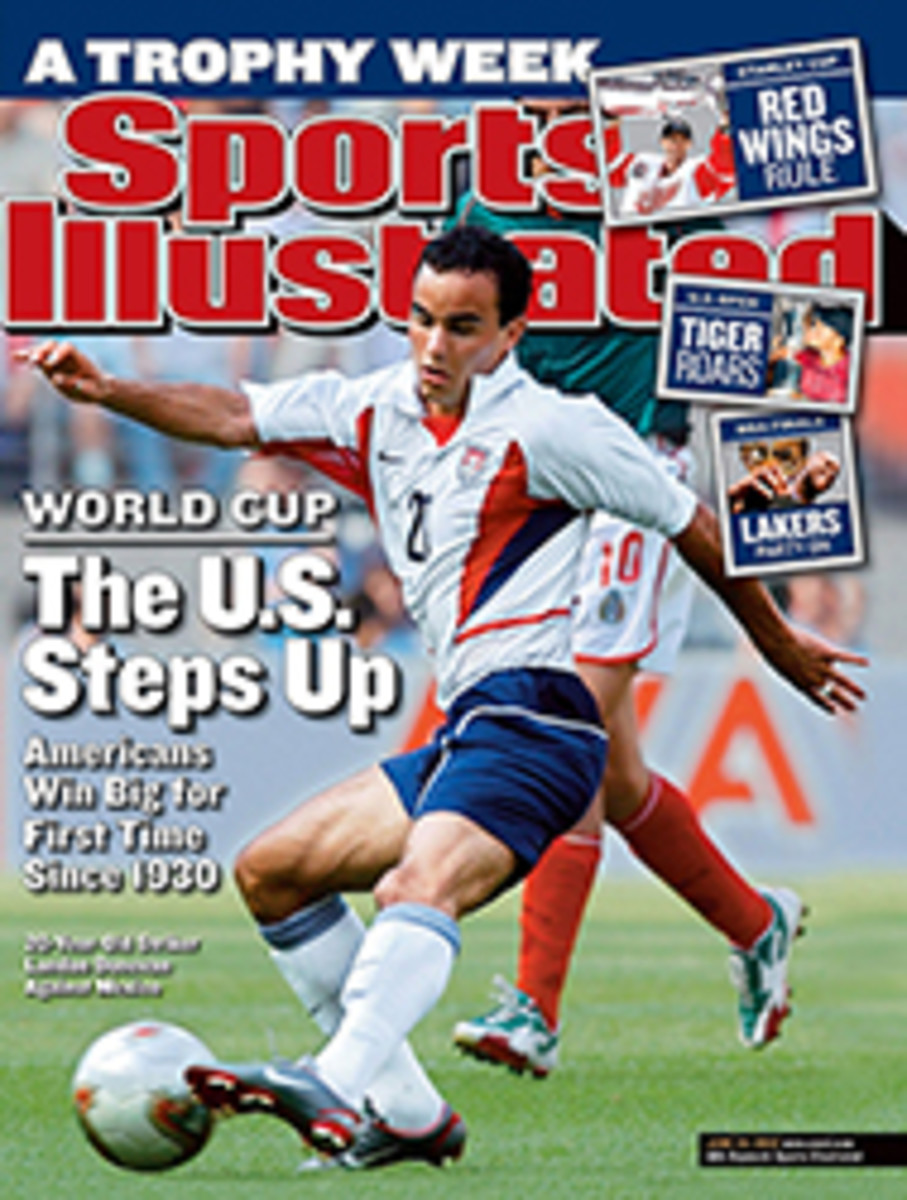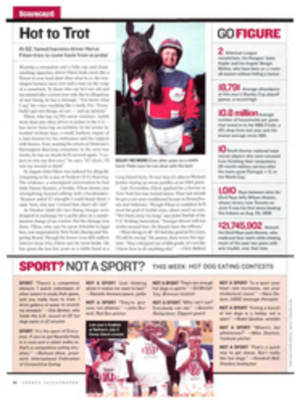
Pour Sports After slogging Round 2 on one of the most miserable days in U.S. Open history, many of the players were crying foul
Every year the USGA sets up a course for the U.S. Open that's as
unforgiving as last year's bathing suit. The course is designed
to test the players, not showcase them, and as the USGA proved
last Friday at Bethpage Black, there is no grading on a curve.
The inch of rain that fell on the course during the second round
turned the rough into a club-grabbing jungle, while the cool,
clammy air swatted down more shots than Shaq ever will. The
USGA's stance: Play away, please. Tom Meeks, the senior director
for rules and competitions, is the official who determined the
positions of the tees and the pins. Asked on Friday night if he
considered easing the setup because of the weather, he said,
"We've never done that. I hope we never do."
The dilemma, however, is that just as the USGA pushes the
players to the limit, it pushes the fairness of the course to
its limit too. When the weather turns as nasty as it was on
Friday in Farmingdale, N.Y., an Open venue finds its tipping
point. The result: The world's best golfers are reduced to
hacks. Twenty-nine players in the field of 155 failed to break
80 in the second round. The average score was 76.48, the sixth
highest in any major since 1990. Only four golfers finished in
the 60s: Shigeki Maruyama, whose low round of 67 included an ace
at the 161-yard 14th, Padraig Harrington (68), Tiger Woods (68)
and John Maginnes (69).
It's no coincidence that two of the highest-scoring days in
recent Open history were played in dreadful weather. The opening
round of the '86 Open at Shinnecock Hills (77.81) was played in
a northeaster, and during the final round of the '92 Open,
Pebble Beach (77.27) was buffeted by 40-mph winds. Veterans who
had endured one or both of those rounds dismissed them in
comparison to what they endured at Bethpage. "The conditions at
Shinnecock were comparable, but this course is harder," said Tom
Lehman, who shot a 76 and came in three strokes under the
36-hole cut of 150 (the highest since '86). Others weren't so
sanguine. "Come hell or high water, that's how the USGA was
going to set it up," said Hal Sutton, "and that's what came."
Sutton, who tied for fourth at Shinnecock, shot a 77-77-154 at
Bethpage and called the setup the worst job the USGA had ever
done.
At 7,214 yards the Black was already the longest course in Open
history. The two longest par-4s, the 492-yard 10th and the
499-yard 12th, drew the most criticism because of the forced
carries required off the tee: 248 yards at the 10th, 264 yards
at the 12th. In the 90[degrees] heat of the practice rounds,
driving the ball that far wasn't a problem. Early in the week
most players hit a three-wood off the 10th tee. In the dank,
58[degrees] air on Friday, the 10th fairway may as well have
been in Manhattan. As Dudley Hart and his playing partners,
Steve Pate and Paul Stankowski, left the 10th tee on Friday
afternoon, having failed to reach the short grass, Pate asked a
marshal if anybody had reached the fairway. "Not in the previous
four groups," the marshal replied, "and you're the fifth."
Pate's drive of 236 yards landed well short. He said he aimed
for the seven-foot-wide walkway mowed through the fescue that
stretched from the tee to the fairway.
Scott Verplank, who shot a 78 on Friday, said that when he saw
the height and thickness of the fescue that swallowed up his
226-yard drive on number 10, "I thought about declaring an
unplayable lie, going back to the tee and hitting another ball.
I could keep hitting it there and going back for an hour and a
half. I was never going to get it over the high stuff. The USGA
did a poor job. Obviously they didn't watch the Weather Channel."
When the day ended, number 12 was the third most difficult
fairway to hit (51.6%) and number 10 the fifth (53.5%). What
galled the players at each hole was the lack of a second option
to the forced carry. At number 12, a dogleg left, a bunker
spanned nearly the width of the fairway. A landing area to the
right of the bunker about eight yards wide served as a bailout.
"The option they leave you is to hit a three-iron short of the
bunker and play it like a par-5," said Olin Browne, who shot an
81 and missed the cut.
The weather strained the resources of the tournament staff. The
USGA began the day with approximately 600 towels, and the
caddies snatched them up as if they were free sandwiches. The
supply ran "dangerously low," according to Jeff Poplarski, the
chairman of the caddie committee. Police wouldn't allow delivery
trucks on the grounds during the day for security reasons, so
volunteers shuttled cars full of wet, muddy towels to a local
laundry and rushed back with clean ones. Though many in the
gallery of 42,500 left the course early, those who stayed made a
beeline for the merchandise tent. A thousand $10 rain ponchos
went out the door in the first half hour. For the day the USGA
sold about 2,700 umbrellas (priced at $29 or $52), including a
shipment of 600 that was hustled to the site.
If only the USGA staff on the course had adjusted as well. Meeks
is an unassuming man with stooped shoulders and a slight
Midwestern twang. His approachability camouflages his conviction
that the USGA is always right and that the players need to suck
it up. When he was told on Friday that only 11 players hit the
green in regulation at number 7, a par-5 converted into a
489-yard par-4, Meeks expressed surprise at the statistic, but
it didn't change his mind. "If none of them had reached the
green in two," he said, "it wouldn't tell me that the hole is
not fair. It tells me that it's hard." Phil Tataurangi hit
driver-driver to the 7th green and sank a 25-foot putt, one of
two birdies the hole yielded all day. "It's unfair," Tataurangi
said later, "but there is one guy who didn't have a problem with
the course. That's the USGA's argument."
The one guy Tataurangi had in mind wasn't Maginnes, who birdied
16, 17 and 18 to finish under par. Sergio Garcia's claim that
the USGA would have suspended play in the afternoon had Woods
been on the course bordered on paranoia, but he was not alone in
believing that the USGA tailors its decisions to Tiger's
measurements, especially in the setup of a course. "The USGA
made it playable for one guy," Verplank said, "and he's a freak
of nature." Added Jeff Sluman, who shot 73 on Friday, "Today the
USGA determined that the man who can carry it the farthest, not
hit it the straightest, will benefit." Meeks dismissed the
distinction between distance and carry. "I rest my case in
saying that everybody in this field can hit a ball 250 yards."
Meeks allowed that "we might bring the fairway back closer to
the tee" on number 10 when the Open returns to Bethpage. By then
it will be too late for such players as John Cook, 44. As he
cleaned out his locker after his 74-77-151, Cook questioned the
USGA's motives. "They could have moved up the tees 10 yards at
number 12," he said, "but then they wouldn't have had the
longest par-4 in Open history. It was an ego thing."
Cook flipped open his cellphone, saw a text message on the
screen and let out a whoop. "Jason shot a 71 today," he said,
referring to his 16-year-old son, who was playing in a junior
tournament in Greensboro, N.C. Cook chuckled and said, "The son
beat his father."
From a nearby locker Justin Leonard couldn't resist the opening.
"A lot of sons beat their fathers today," he said.
COLOR PHOTO: ROBERT BECK (WOODS) COVER INSET U.S. OPEN TIGER ROARS
COLOR PHOTO: PHOTOGRAPH BY FRED VUICH [INSIDE T OF C] RAISING THE ROOF Fans perched atop the halfway house at Bethpage Black to get a better view of Phil Mickelson as he hit his tee shot on the 6th hole on Sunday.
COLOR PHOTO: PHOTOGRAPH BY JOHN BIEVER TIGER TAIL With a two-under-par 68, Woods was one of only four players to shoot in the 60s on waterlogged Friday, when the average score was 76.48.
COLOR PHOTO: ROBERT BECK WET BLANKET Garcia accused the USGA of playing favorites, saying the Open would've been halted had Woods been on the course.
COLOR PHOTO: FRED VUICH MAKING WAVES An inch of rain fell during the day, making it necessary for the greens to be constantly squeegeed in the afternoon.
COLOR PHOTO: ROBERT BECK PUT A LID ON IT Players tried anything to keep dry, but no one went to the lengths of Rocco Mediate, who put on a pair of hats.
COLOR PHOTO: FRED VUICH HIGH AND DRY A bumper crop of bumbershoots arose as fans made a beeline for the merchandise tents.
"The USGA did a poor job," said Verplank. "Obviously they didn't
watch the Weather Channel."
Volunteers shuttled cars full of wet, muddy towels to a laundry
and brought back clean ones.

